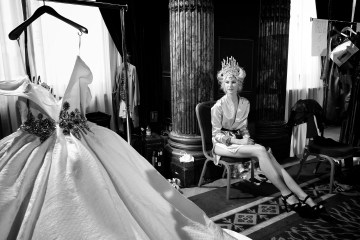For toy manufacturers in the U.S., less was definitely not more in 1964. That year Topper Toys produced Johnny Seven OMA, a toy weapon that included seven functionalities such as a grenade launcher, antitank rocket, armor-piercing shell, repeating rifle, Tommy gun and automatic pistol. (As you may have deduced, OMA stands for One-Man Army.) Hasbro launched the now iconic G.I. Joe around the same time, but it was the Johnny Seven rifle that went on to become the best-selling boys’ toy of the year. “Your squad is ready for you to lead them through. With Johnny Seven OMA, you charge!” says the enthusiastic narrator in the original commercial. “Johnny Seven’s got ’em on the run!”
Despite the ever-present debate over violent toys and video games in the U.S., it wasn’t Americans who dreamed up toys that hint of violence and aggression. “War Games,” an exhibition at London’s Museum of Childhood, which opened May 25, looks at how toy manufacturers have, for centuries, re-created and represented war, thereby stirring a sense of militarism and patriotism in children. In addition to Johnny Seven OMA, the museum has gathered more than 100 other objects from its own collection, as well as from private collectors, other British museums and Germany’s Spielzeugmuseum in Nuremberg. They include cardboard soldiers produced in 1870, shortly after the Franco-Prussian War, and Escape From Colditz, a 1970s board game inspired by a prisoner-of-war camp in Germany.
Ieuan Hopkins, co-curator of the exhibition, says that war pervades children’s lives whether they have a relative on the front lines of Afghanistan or merely have the evening news on in the background. “Play is all about understanding the world around you,” he says, “and there’s always a war on somewhere in the world.”
Hopkins began thinking about the exhibition three years ago while archiving photographs and other historic materials at the museum. During World War II, toy manufacturers stopped making toys and started making weapons. The photographs that inspired Hopkins showed women inside the factory of Lines Bros. — Britain’s most famous toy manufacturer at the time — churning out firearms and shells rather than model cars and train sets.
The exhibition revolves primarily around German, American and British toys. “The people who have waged the most wars tend to be the countries that produce the most toys,” says Sarah Wood, the show’s other curator. “There’s an interesting interplay of Britain representing itself and representing Germany, and not always presenting themselves as the heroic party.” Following World War I, for instance, German manufacturers portrayed Germany as injured and therefore vulnerable. With German forces not allowed heavy arms and tanks, toy manufacturers made figurines of German soldiers on motorbikes and with rifles, and others of German soldiers on stretchers in field hospitals. Later, with the rise of Hitler, toy companies saw demand spike for figures and toys representing the Nazi Party. Cue the Führer Limousine, a tinplate clockwork car with four passengers, each wearing an S.S. uniform with swastika armband.
“These toys illustrate the times really well,” says Hopkins. “They were considered perfectly fine in their contemporary context, but today we see them differently.”
The Nazi cars aren’t the only toys that now seem wholly inappropriate. The Get Those Japs dartboard, released around 1942, stirred anti-Japanese sentiment following the surprise attack on Pearl Harbor. With the tagline “Now’s your chance!” the game saw players throwing darts at Japanese caricatures who had red targets — reminiscent of the country’s national symbol of the rising sun — on their buttocks and backs. The ill will continued after the war. Within six months of the U.S. dropping atomic weapons on Japan, the A.C. Gilbert Co. released a paper toy called Atomic Bomb. The base of the handheld box featured a map of Japan — with a large atomic missile printed in one corner — and users had to navigate two balls into slots labeled Hiroshima and Nagasaki.
Of course, toy manufacturers are businesspeople. As such they’ve always understood the importance of balancing the public’s appetite for toys with its disgust for war. By the end of the 1960s — with the Vietnam War raging and mass casualties dominating the airwaves — toy companies began to expand their lines beyond toys of conflict. “You could still buy a militarized G.I. Joe, but you could also buy an Adventure Team G.I. Joe,” Wood says. “He’s an action figure without a gun, and without the need to kill or be aggressive.”
One way to tap into children’s interest in conflict — without seeming to profiteer from war — is to move that conflict into outer space. Mattel certainly did well with its Masters of the Universe figurines in the 1980s. That fascination for interstellar battles continues today. Lego’s official line is that it does not make realistic war toys. But in 2012, it released the Death Star play set, which re-creates scenes from Star Wars movies with, among other things, its “firing laser cannon, Imperial conference chamber, droid maintenance facility, and the powerful Death Star superlaser.”
Toys produced during the Cold War featured the most overt messaging. Throughout the political stalemate between the Western and Eastern blocs, toymakers and comic-book publishers merged the public’s fear of nuclear weapons with its fear of communism. In the Iron Man comics, the hero must fight Russian jets when he accidentally veers into Soviet airspace. And the Incredible Hulk is a victim of nuclear fallout. In the comic book Chain of Command, a U.S. soldier fires a bazooka at the Viet Cong while his comrade shouts, “Make every shot count, Willy. We’re short on ammo!” Language elsewhere in the comic isn’t fit to reprint. “It’s sometimes surprising how blatantly toys and comics have been used as propaganda,” Hopkins says. “It makes you question how innocent they are as playthings.”






